|
DIAGNOSIS OF HEARTWORM DISEASE

The chief issue in the diagnosis of heartworm disease centers around detecting the presence of living heartworms in the host's body. This sounds pretty straightforward but it turns out that different tests detect different life stages of heartworm and not all life stages may be present in a given dog. Further, different stages require different treatments. Some tests evaluate the extent of concurrent heart disease while others simply look for worm proteins. The following are a list of diagnostic methods that have been and are used in the detection of heartworms within the pet dog's body as well as an explanation of what information each test provides.
As a refresher, keep in mind:
- Microfilariae are the baby worms produced by mating male and female adult worms living in the heart and pulmonary arteries. Microfilariae circulate freely in the bloodstream.
- Adult worms, as mentioned, live in the heart and pulmonary arteries and do not circulate around the body.
|
DIRECT BLOOD SMEAR
While this method is a simple screening test, it is not recommended as a regular test method. In this test, a single drop of blood is examined under the microscope for the presence of live microfilariae. If a large number of microfilariae are present, chances are at least one will be seen swimming by. Of course, detection of heartworm larvae in this way requires large numbers of larvae for detection (less than 20-50 microfilariae per ml of blood will not be detected). More subtle infections will be missed.
|
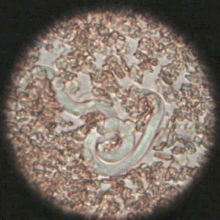
microfilaria in a blood smear
(Photo Credit: Joel Mills via Wikimedia Commons)
|
|
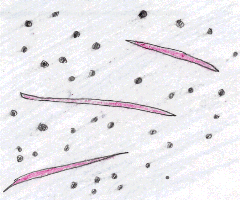
Microfilaria on a positive heartworm test
(original graphic by marvistavet.com)
|
DIFIL TEST AND KNOTT’S TEST
These tests represent "concentration" methods for the detection of microfilariae so that more subtle infections can be detected. In these tests, a larger amount of blood is either centrifuged or filtered to concentrate any microfilariae present. When a microfilaria test is to be done, either of these would be appropriate. Antigen testing had largely supplanted microfilaria testing as simple antigen test kits became available but more recently, The American Heartworm Society has revised its guidelines, now recommending that microfilaria testing be included in basic heartworm testing for dogs. Expect that either Knott's or Difil testing will be included in basic heartworm test screening tests.
|
|
DIPETALONEMA RECONDITUM: THE OTHER MICROFILARIA
Heartworm is not the only species of worm that has circulating microfilariae as a first stage larva. There is another parasite called Dipetalonema reconditum which may be picked up by the microfilaria tests. This parasite is transmitted by fleas. Subtle differences in the swimming characteristics, nose structure, and tail structure can be used to distinguish this harmless larva from the more serious heartworm microfilaria. Before immunotechnology, there was an element of diagnostic challenge when microfilaria were detected in the blood (was the nose the shape that would justify a harsh and possibly life-threatening treatment for heartworm infection or was it a harmless creature for which no treatment was needed?) The advent of antigen testing has made this distinction much easier to make.
|
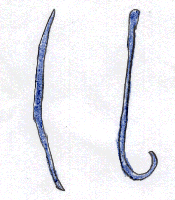
Dirofileria immitus (left) has a pointy nose, while Dipetalonema's nose is flat. Dirofilaria has a straight tail while Dipetalonema has a curvy tail.
(original graphic by marvistavet.com)
|
|
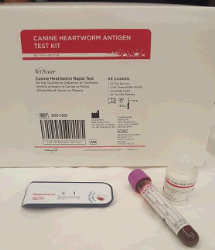
An example of an ELISA test for in house use.
(original graphic by marvistavet.com)
|
ANTIGEN TESTING:
(CAN ONLY DETECT YOUNG ADULT FEMALE WORMS)
Using genetic engineering, it has become possible to create extremely sensitive tests capable of detecting tiny pieces of adult female heartworm skin circulating in the blood. (Technology exists only to detect female worm proteins; male worms are undetectable). In this way, very small numbers of adult worms can be detected, even single worm infections as long as at least one female worm is involved. This kind of testing has made it possible to detect infections in which no microfilariae are present: the so-called "Occult infections." Most of these immunological tests are available as test kits which can be performed in the veterinarian's office while you wait.
|
NO MICROFILARIAE??
There are many important reasons why a dog might be infected with adult heartworms yet no microfilariae can be detected:
- Single sex infections or single worm infections
Younger female worms tend to be resistant to the drugs used to clear adult worms. This means that after the first treatment with anti-heartworm medication, a group of young female worms will be left. If antigen testing is not performed, one could be misled into thinking that the infection had been completely cleared. It is also worth noting that a single sex population with male worms not only will not produce microfilariae but will not be detectable even with antigen testing.
- Immunologic destruction of microfilariae
In the cat, the period in which microfilariae can be detected in the blood stream is extremely short as the immune system rapidly groups and clears these larval worms.
- The dog is taking heartworm prevention medication
Milbemycin, ivermectin, moxidectin, and selamectin are able to kill circulating microfilariae (but not adult heartworms). If for some reason, a dog is not properly tested and has missed a dose of medication, it is possible for an infection to establish yet no microfilariae will be detected. People commonly ask why they must continue annual testing in animals that are on preventive medication; this is one reason.
Since Dipetalonema microfilariae can be mistaken for heartworm larvae and since microfilariae can be transferred to unborn puppies (but adult heartworms cannot), it is felt by many specialists that no microfilaria positive dog should be treated for heartworm without a positive antigen test.
|
THE NEWEST RECOMMENDATIONS BY THE AMERICAN HEARTWORM SOCIETY ARE FOR
DOGS TO BE TESTED WITH BOTH AN ANTIGEN TEST AND A MICROFILARIA TEST ANNUALLY.
ANTIGEN TESTING ALONE IS NOT ADEQUATE.
|
|
|
ANTIBODY TESTING: ESPECIALLY IMPORTANT FOR CATS
Antigen tests have limited usefulness when it comes to infections involving only a few worms. One problem is that the antigens detected by antigen tests are unique to female worms; animals infected with only male worms will test antigen negative. To get around these limitations, antibody tests have been developed to detect the host's immune response against the parasite. This kind of breakthrough has been especially important in testing for cats because feline heartworm infections typically only involve one or two worms. Antibody testing may be able to detect infection sooner than can antigen testing and infections involving only male worms can be readily detected. As a general rule, testing for dogs involves an antigen test and a microfilaria test while testing for cats involves an antibody test plus an antigen test.
|

(photocredit: MorgueFile.com)
|
HOW OFTEN SHOULD A DOG BE TESTED?
With differences in weather patterns every year (i.e. early spring one year, late freeze another year etc.), it becomes difficult to figure out in what month heartworm preventive medication should be initiated. If there is any question about when the last possible transmission date was in the previous season, it is probably a good idea to simply test the dog annually. The American Heartworm Society recommends annual testing as this allows infection to be detected most promptly thus minimizing damage to the pet from the infection.
If there is any question about the dog spitting out any preventive tablets last season , then the dog should be tested before beginning prevention the next season.
If a dog lives in an area considered not to have heartworm and travels to an area that IS considered to have heartworm, both microfilaria and antigen testing should performed at least seven months after the last day the dog was present in the heartworm endemic area.
For more information on the different medications used in the prevention of heartworm infection, see heartworm prevention.
RADIOGRAPHS AND ULTRASOUND
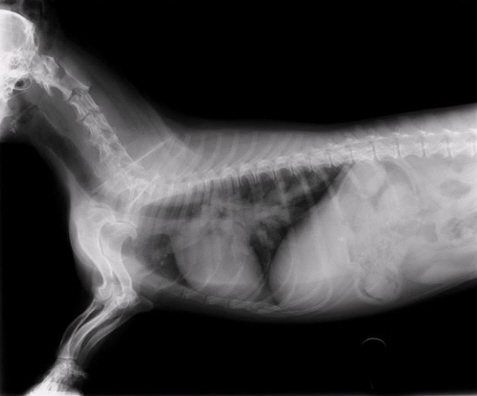
Chest radiograph from a severely affected dog
(Photocredit: Veterinary Information Network)
In areas where heartworm infection is not common, routine testing is not performed and infection is unlikely to be detected until the dog is sick or unless a routine test finds it incidentally. In cases where the dog is sick, the infection is picked up during the work-up for heart disease.
Radiographs can be strongly indicative of heartworm infection if they show blunted tortuous pulmonary arteries and enlargement of the right side of the heart (the side doing all the extra work to pump blood past the worms).
Ultrasound not only can measure thickening of the right side of the heart but can actually show the live worms wiggling.
When imaging tests are consistent with heartworm disease, antigen and/or microfilaria testing would be the obvious next step.
BECAUSE OF THE 5-MONTH MINIMUM MIGRATION TIME
OF THE LARVAL HEARTWORM AFTER INFECTION,
IT IS OF NO USE TO HEARTWORM TEST DOGS
YOUNGER THAN 5 MONTHS OF AGE.
THESE PUPPIES ARE TOO YOUNG TO HAVE ADULT HEARTWORMS
AND ARE TOO YOUNG TO TEST POSITIVE UNDER ANY CIRCUMSTANCES.

Page last updated: 7/1/2025
|